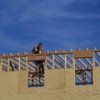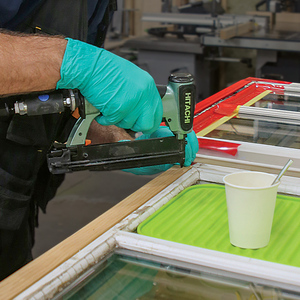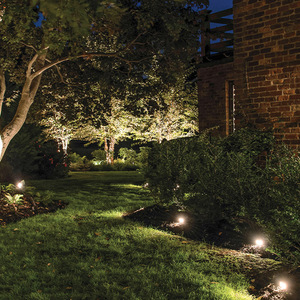I have to construct a knee wall in my attic, & was wondering what the consensus was here in terms of the best way for the top of the wall to meet the rafters.
I’ve seen a couple of different methods:
House #1) The knee wall studs were cut at an angle & toe nailed directly to the rafters with no top plate – this was a VERY old house, don’t know if this is approved today or not
House #2) The knee wall studs were again cut at an angle, but this time a top plate was nailed directly to the rafters & the studs were toe nailed to the top plate (more recent house, but still kinda old)
House #3) The knee wall studs were cut square & fastened to the top plate – this resulted in only the back edge of the knee wall contacting the rafters. They then took roughly 8″ pieces of scrap 2×4 & through nailed them into the side of the rafters with the bottom edge of the scrap toe nailed to the top plate of the knee wall.
Are all three of these methods common? Which is most preferred?




















Replies
I'll take what's under box # 2.
"Oh, this is the worst-looking hat I ever saw. What, when you buy a hat like this I bet you get a free bowl of soup, huh? Oh, it looks good on you though."
House #4) (My house!) Top plate is doubled and beveled to match the underside of the rafters. Studs cut square.
Mike Hennessy
Pittsburgh, PA
Is it too late to change my answer?I was thinking after that you would want to bevel cut the top plate in a way that would keep the vertical surface plumb, that way there would be a nice flat nailer surface for the drywall at the top of the kneewall.
Edited 3/16/2006 2:06 pm ET by xosder11
The top plate is flush with the fronts of the studs and perpendicular. Like this, but not so steep:
||_ <-- Doubled 2X4s, beveled to match the roof slope.| || | <-- Studs| |
Mike HennessyPittsburgh, PA
Did this a couple years ago myself. Any of the above choices will work assuming no structural considerations exist. The top plate approach may just get in the way of insulation. In my case, we skipped the top plate altogether as the rafter spacing was 16" O.C. anyway and a plate would not have helped much with drywall.
Here are a few other considerations for you:
1. What's the spacing and pitch on the rafters? Will the knee walls be transferring (snow) loads to the attic floor once in place? Will the attic floor now be transferring loads to the roof (no-no)? This may either be an engineering feature or a problem downstairs should the rafters deflect in any meaningful way.
2. Will you be insulating the new knee walls and cathedral ceiling? Since the answer should be yes, will you be venting the attic behind the knees and what insulation will you be using? The style of plates you choose could either help or hurt here.
3. Be sure to use lines/lasers to align the top of your knee wall as almost no existing rafter system ever lines up perfectly. In my case, I had to furr out the rafters as much as a couple inches in some places to get a decent finished wall.
Have fun.
"In my case, we skipped the top plate altogether as the rafter spacing was 16" O.C. anyway and a plate would not have helped much with drywall."That's what I was wondering. Why not set a base plate and then attach to the existing rafters? A top plate seems like additional work, and the kneewall isn't structural.Or does there need to be something for the corner bead to attach to?
"Or does there need to be something for the corner bead to attach to?"That's my assumption. It's basicly acting like blocking for a surface to support the ends of the wall material. How else would you handle supporting the ends of the ceiling and wall material where they meet at the top of the kneewall? I'm sure there are ways, but adding a top plate seems as good as any to me."Oh, this is the worst-looking hat I ever saw. What, when you buy a hat like this I bet you get a free bowl of soup, huh? Oh, it looks good on you though."
How else would you handle supporting the ends of the ceiling and wall material where they meet at the top of the kneewall?
In a normal ceiling/wall board install, the ceiling should float on the top of the wall board anyway to avoid lift cracks etc. right? So the top plate is really only there for structural reasons, not drywall reasons. You're right, that if you've got wide rafter spaces and a low pitch, you may get bowing and sagging in between studs without a top plate to help out the lower wall board.
When we did mine, we had neither, so things worked fine using just Strait-Flex with no plate.
It also made using insulation batts much easier as they're continuous from floor to ceiling.
No cracks or other issues to report.
That's what I was wondering. Why not set a base plate and then attach to the existing rafters? A top plate seems like additional work, and the kneewall isn't structural.
Or does there need to be something for the corner bead to attach to?
In my case, we used Strait-Flex instead of paper or mesh tape and it provided adequate stiffness for the joint. We also used full 1/2" board, so the space in between 16" O.C. rafters was plenty stiff. BTW, I love the Strait-Flex product since even the most careless use of a taping blade will rarely pierce the tape and it always gives a razor sharp joint line.
Should your rafters be spaced more like 24" O.C., then you probably should use a top plate since there may be too much flex in the board between rafters.
Sorry if I wasn't specific enough in my OP. Anyway, here are the answers to your questions:
1. What's the spacing and pitch on the rafters? Will the knee walls be transferring (snow) loads to the attic floor once in place? Will the attic floor now be transferring loads to the roof (no-no)? This may either be an engineering feature or a problem downstairs should the rafters deflect in any meaningful way.
Roof is 7/12 pitch & yes the knee walls will be transferring snow load to the attic floor - that's how it was drawn up by my architect.
2. Will you be insulating the new knee walls and cathedral ceiling? Since the answer should be yes, will you be venting the attic behind the knees and what insulation will you be using? The style of plates you choose could either help or hurt here.
This is an unfinished attic, so there will be no insulation (other than the attic floor)
3. Be sure to use lines/lasers to align the top of your knee wall as almost no existing rafter system ever lines up perfectly. In my case, I had to furr out the rafters as much as a couple inches in some places to get a decent finished wall.
Understood.
Soultrain... general rule of thumb we use, but may or may not work for you. Personally, I'd call the architect and ask what he'd like to see.
If the knee wall was designed to lesson the span of the rafters and put some of the roof load onto the floor system then we cut in a second birdsmouth in the rafters to receive the knee wall. This gives the most direct and true vertical load path.
If the wall simply exists to seperate unfinished space from finished space, we opt for what I believe was option #2 on your list. A top plate nailed to the rafters with the studs cut to the roof pitch.